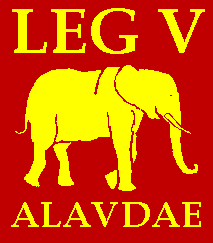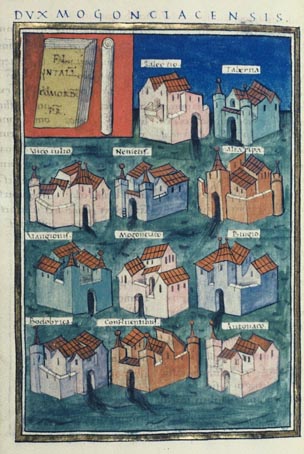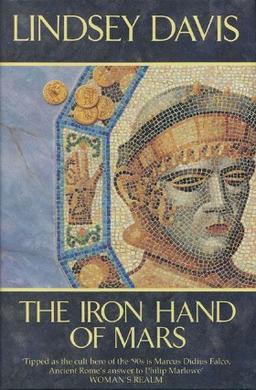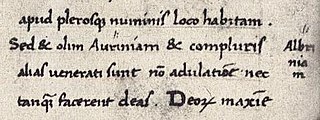Maroboduus, also known as Marbod, was a king of the Marcomanni, who were a Germanic Suebian people. He spent part of his youth in Rome, and returning, found his people under pressure from invasions by the Roman Empire between the Rhine and Elbe. He led them into the forests of Bohemia, near to the Quadi who already lived nearby, and established a large alliance.

Gaius Julius Civilis was the leader of the Batavian rebellion against the Romans in 69 AD. His nomen shows that he was made a Roman citizen by either Augustus or Caligula.

Legio V Alaudae, sometimes also known as Legio V Gallica, was a legion of the Roman army founded in 52 BC by the general Gaius Julius Caesar. It was levied in Transalpine Gaul to fight the armies of Vercingetorix, and was the first Roman legion to comprise non-citizens. Historians disagree whether the legion was destroyed during the Batavian rebellion in AD 70, or during the First Battle of Tapae.

The Revolt of the Batavi took place in the Roman province of Germania Inferior between AD 69 and 70. It was an uprising against the Roman Empire started by the Batavi, a small but militarily powerful Germanic tribe that inhabited Batavia, on the delta of the river Rhine. They were soon joined by the Celtic tribes from Gallia Belgica and some Germanic tribes.

The Bructeri were a Germanic people, who lived in present-day North Rhine-Westphalia, just outside what was then the Roman empire. The Romans originally reported them living east of the lower Rhine river, in a large area centred around present day Münster stretching from both sides of the upper River Ems in the north, to both sides of the River Lippe in the south. At its greatest extent, their territory apparently stretched between the vicinities of the Rhine in the west and the Teutoburg Forest and Weser river in the east.
Quintus Petillius Cerialis Caesius Rufus, otherwise known as Quintus Petillius Cerialis, was a Roman general and administrator who served in Britain during Boudica's rebellion and went on to participate in the civil wars after the death of Nero. He later crushed the rebellion of Julius Civilis and returned to Britain as its governor.
In Germanic paganism, a seeress is a woman said to have the ability to foretell future events and perform sorcery. They are also referred to with many other names meaning "prophetess", "staff bearer" and "sorceress", and they are frequently called witches both in early sources and in modern scholarship. In Norse mythology the seeress is usually referred to as völva or vala.

The Lingones were a Gallic tribe of the Iron Age and Roman periods. They dwelled in the region surrounding the present-day city of Langres, between the provinces of Gallia Lugdunensis and Gallia Belgica.

The Eburones were a Gaulish-Germanic tribe dwelling in the northeast of Gaul, who lived north of the Ardennes in the region near what is now the southern Netherlands, eastern Belgium and the German Rhineland, in the period immediately preceding the Roman conquest of the region. Though living in Gaul, they were also described as being both Belgae and Germani.

The Vangiones appear first in history as an ancient Germanic tribe of unknown provenance. They threw in their lot with Ariovistus in his bid of 58 BC to invade Gaul through the Doubs river valley and lost to Julius Caesar in a battle probably near Belfort. After some Celts evacuated the region in fear of the Suebi, the Vangiones, who had made a Roman peace, were allowed to settle among the Mediomatrici in northern Alsace.. They gradually assumed control of the Celtic city of Burbetomagus, later Worms.

The Morini were a Belgic coastal tribe dwelling in the modern Pas de Calais region, around present-day Boulogne-sur-Mer, during the Iron Age and the Roman period.

The Iron Hand of Mars is a 1992 historical mystery crime novel by Lindsey Davis and the fourth book of the Marcus Didius Falco Mysteries series. Set in Rome and Germania during AD 71, the novel stars Marcus Didius Falco, informer and imperial agent. The iron in the title refers to the standard, shaped like a giant hand made of iron, which Falco is required to deliver to the imperial legions in Germany.
Julius Classicus was a Gaulish nobleman and military commander of the 1st century AD, belonging to the tribe of the Treviri. He served as a commander of the Roman auxiliaries. Along with Julius Tutor, another Treviran Roman auxiliary commander, and Julius Sabinus, who claimed descent from Gaius Julius Caesar, he joined the rebellion of Gaius Julius Civilis during the disorder of the Year of the Four Emperors.

For around 450 years, from around 55 BC to around 410 AD, the southern part of the Netherlands was integrated into the Roman Empire. During this time the Romans in the Netherlands had an enormous influence on the lives and culture of the people who lived in the Netherlands at the time and (indirectly) on the generations that followed.

Ganna was a Germanic seeress, of the Semnoni tribe, who succeeded the seeress Veleda as the leader of a Germanic alliance in rebellion against the Roman Empire. She went together with her king Masyus as envoys to Rome to discuss with Roman emperor Domitian himself, and was received with honours, after which she returned home. She is only mentioned by name in the works of Cassius Dio, but she also appears to have provided posterity with select information about the religious practices and the mythology of the early Germanic tribes, through the contemporary Roman historian Tacitus who wrote them down in Germania. Her name may be a reference to her priestly insignia, the wand, or to her spiritual abilities, and she probably taught her craft to Waluburg who would serve as a seeress in Roman Egypt at the First Cataract of the Nile.
The gens Rutilia was a plebeian family at ancient Rome. Members of this gens appear in history beginning in the second century BC. The first to obtain the consulship was Publius Rutilius Rufus in 105 BC.

Albruna, Aurinia or Albrinia are some of the forms of the name of a probable Germanic seeress who would have lived in the late 1st century BC or in the early 1st century AD. She was mentioned by Tacitus in Germania, after the seeress Veleda, and he implied that the two were venerated because of true divine inspiration by the Germanic peoples, in contrast to Roman women who were fabricated into goddesses. It has also been suggested that she was the frightening giant woman who addressed the Roman general Drusus in his own language and made him turn back at the Elbe, only to die shortly after, but this may also be an invention to explain why a consul of Rome would have turned back. In addition, there is so little evidence for her that not every scholar agrees that she was a seeress, or that she should be included in a discussion on them. She may also have been a minor goddess, a matron.

The Classis Germanica was a Roman fleet in Germania Superior and Germania Inferior. Besides the Channel Fleet, it was one of the largest naval forces of the Roman Empire, ranking above all other provincial fleets.

Quintus Julius Cordinus Gaius Rutilius Gallicus was a Roman senator who held several posts in the emperor's service. He was twice suffect consul: for the first time in the nundinium of September to October 70 AD; and the second time in 85 with Lucius Valerius Catullus Messalinus as his colleague, succeeding the Emperor Domitian.
















